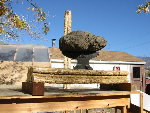
StrawjetA project of the Ashland School
|
|||

 |
|
 |
||||||||||||
ContentsStrawjet ProjectHow it WorksNewsSupport ASETContactHome |
The challengeEver since the Three Little Pigs experimented with straw, everyone knows that straw is not a good building material, so why are we trying? In grain growing regions of the country, there is a huge surplus of straw, to the extent that it was often burned as a nuisance. In California and other populated regions, this practice has been banned because the smoke was a health hazard. Finding a good use for the straw seemed like a problem worth solving. Current building materials contain a variety of resins, coatings and binders that emit toxic fumes during and after the building process. An increasing number of people are suffering from health problems related to these toxins. If our straw house could be built without toxic resins we could solve another problem. Forests are being depleted throughout the world for both timber and fuel. In addition to the well publicized problem of habitat loss, deforestation is a significant factor in accelerating global warming. The solution Since straw can carry significant loads only in compression parallel to the stem, the first task is to bundle the straw so that it is oriented parallel to the load, and the stems are not crushed. David Ward invented the Strawjet machine to accomplish this task. The machine that has evolved accomplishes this by compressing the straw into a 2 inch diameter cable and securing it with a wrapping of polyester yarn. One of the challenges in creating a structure that will support a load is binding the individual stems so they do not slide against each other. Experiments are currently underway using clay, papercrete, and differing levels of moisture to find the best compromise between strength, insulation value and cost.
|
|
||||||||||||
|
||||||||||||||
|
||||||||||||||
|
During field trials it became apparent that one machine could not perform all the tasks required. Currently we are working to modify a conventional mower/conditioner used for cutting Alfalfa to cut the straw in the field and mix in the water and clay binder. The mixture would be divided into windrows just the right volume to feed into the Strawjet machine that would follow some distance behind. |
||||||||||||||
|
A third machine, the Strawcore Binder assembles 4 cables in a square pattern with a papercrete binder and wraps them together with yarn. A final coating of papercrete completes the process. The form of papercrete used in this process is made from recycled paper, clay bearing soil, and a small amount of Portland cement. |
|
|||||||||||||
|
Multiple bundles can then be combined to form beams, panels or other structural members. |
|
|||||||||||||
|
|
Strawcore members can be assembled either individually or as multiple units to form walls, arches and other structures. A wall can be made of two layers, one horizontal and one vertical. In colder climates 3 or even 4 layers could be used to add more insulation, or more load bearing capacity depending on the need. | |||||||||||||